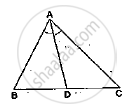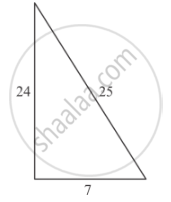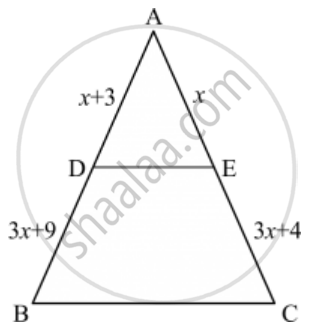Advertisements
Advertisements
Question
In a ΔABC, AD is the bisector of ∠A.
If AB = 5.6cm, BD = 3.2cm and BC = 6cm, find AC.

Solution
It is given that AD bisector ∠𝐴.
Applying angle – bisector theorem in Δ ABC, we get:
`(BD)/(DC)=(AB)/(AC)`
BD = 3.2 cm, BC = 6 cm
Therefore, DC = 6- 3.2 = 2.8 cm
⟹ `3.2/2.8=5.6/(AC)`
⟹ `AC=(5.6xx2.8)/3.2=4.9 cm`
APPEARS IN
RELATED QUESTIONS
The incircle of an isosceles triangle ABC, in which AB = AC, touches the sides BC, CA and AB at D, E and F respectively. Prove that BD = DC.
D and E are points on the sides AB and AC respectively of a ΔABC. In each of the following cases, determine whether DE║BC or not.
AD = 7.2cm, AE = 6.4cm, AB = 12cm and AC = 10cm.

In each of the following figures, you find who triangles. Indicate whether the triangles are similar. Give reasons in support of your answer.

The area of two similar triangles are 36 cm2 and 100 cm2. If the length of a side of the smaller triangle in 3 cm, find the length of the corresponding side of the larger triangle.
In the given figure, ∆AHK is similar to ∆ABC. If AK = 10 cm, BC = 3.5 cm and HK = 7 cm, find AC.

If D, E, F are the mid-points of sides BC, CA and AB respectively of ∆ABC, then the ratio of the areas of triangles DEF and ABC is
∆ABC ∼ ∆PQR such that ar(∆ABC) = 4 ar(∆PQR). If BC = 12 cm, then QR =
In the given figure, the value of x for which DE || AB is

A vertical stick 20 m long casts a shadow 10 m long on the ground. At the same time, a tower casts a shadow 50 m long on the ground. The height of the tower is
In a right triangle ABC right-angled at B, if P and Q are points on the sides AB and AC respectively, then
